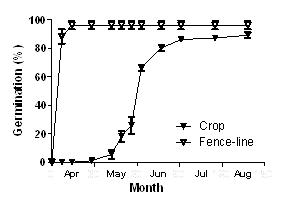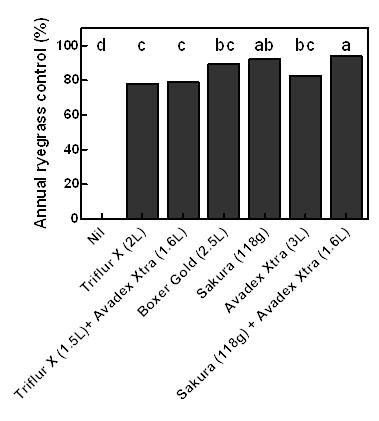Grass weed control - where to from here?
Author: Christopher Preston, Peter Boutsalis, Sam Kleemann and Gurjeet Gill | Date: 15 Aug 2013
Christopher Preston, Peter Boutsalis, Sam Kleemann and Gurjeet Gill,
School of Agriculture, Food & Wine, University of Adelaide
GRDC project code: UA00113, UA00121 and UA00134
Keywords:
barley grass, brome grass, annual ryegrass, herbicide resistance, weed management
Take home messages
- Herbicide resistance is present in the SA Mallee in annual ryegrass to Group A, B and D herbicides and in broadleaf weeds to Group B herbicides.
- Continuous cropping has increased the level of dormancy in populations of brome grass from cropped fields.
- Clearfield® technology currently offers the best management option for brome grass in crops, but has a high risk of resistance.
Herbicide resistance in SA Mallee
A survey of cropped fields on the SA Mallee was conducted in 2012 to determine the levels of herbicide resistance present. Three grass weed species: annual ryegrass, wild oats and brome grass, and three broadleaf weeds: wild radish, Indian hedge mustard and sowthistle, were collected. Herbicide resistance was identified to most herbicides tested in the annual ryegrass samples and the amount of resistance had increased since the last survey in 2007 (Table 1).
Table 1. Extent of resistance in annual ryegrass in the SA Mallee in 2007 compared with 2012.
|
Region |
Year |
Trifluralin |
Hoegrass® |
Glean® |
Intervix® |
Axial® |
Select® |
Glyphosate |
|
Northern Mallee |
2007 |
5 |
2 |
75 |
No test |
2 |
2 |
No test |
|
Southern Mallee |
2007 |
35 |
12 |
59 |
No test |
2 |
2 |
No test |
|
Northern Mallee |
2012 |
17 |
9 |
70 |
36 |
7 |
0 |
0 |
|
Southern Mallee |
2012 |
69 |
30 |
52 |
36 |
16 |
2 |
0 |
Considerably more resistance was identified in the southern Mallee than in the northern Mallee. Both regions had high frequencies of resistance to Group B herbicides, such as chlorsulfuron. Resistance to Trifluralin was low in the northern Mallee, but high in the southern Mallee where 69% of fields were affected. Resistance to trifluralin had increased the most since the last survey in 2007. A concern, given the wide use of Clearfield® technology, is that 36% of populations were resistant to Intervix®.
No resistance was identified in wild oats, brome grass or wild radish in the SA Mallee. Indian hedge mustard was collected from the southern Mallee and 20% of samples were resistant to Group B herbicides. Most of the sowthistle collected in the Mallee was resistant to Group B herbicides: 66% in the northern Mallee and 100% in the southern Mallee.
Increase in seed dormancy in grass weeds from cropped fields
Recent research by Sam Kleemann and Gurjeet Gill has demonstrated that brome grass populations from cropped fields have higher levels of seed dormancy than those from fence lines. The management practices used in continuously cropped fields have shifted the weed population by controlling those individuals in the population that germinated at the season break. Those individuals with increased dormancy have survived and passed that trait on to future generations. The increased dormancy present in brome grass will make management more difficult.

Figure 1. Germination of in crop or fence-line populations of brome grass from a field at Warnertown, SA.
Getting the best out of pre-emergent herbicides
The movement towards no-till crop seeding and the evolution of resistance to post-emergent herbicides has placed increasing reliance on pre-emergent herbicides. The changing nature of the crop seeding environment has changed how pre-emergent herbicides work. In no-till systems, weed seeds are left close to the soil surface and the herbicides are placed on top of the weed seeds. This gives most pre-emergent herbicides the ideal opportunity to work. However, it also creates risks for crop damage that need to be managed.
Two new pre-emergent herbicides, Boxer Gold® (Group J+K) and Sakura® (Group K), have been released in the last 5 years. These herbicides are alternatives to trifluralin (Group D) and will control trifluralin resistant annual ryegrass. In addition, Nufarm are working towards an extension of the label of Avadex® Xtra (Group J). All of these herbicides control annual ryegrass (Figure 2). Rotation of modes of action of pre-emergent herbicides will be important to reduce the risk of resistance to all pre-emergent herbicides.

Figure 2. Control of annual ryegrass 50 days after sowing with pre-emergent herbicides in wheat at Freeling, SA in 2011.
Boxer Gold® and Sakura® have different characteristics to trifluralin, which need to be considered when using the products. Boxer Gold® and Sakura® are more water soluble than trifluralin. This has advantages in that they will not become tied up on stubble, but disadvantages in that the risk of movement into the crop seed row is higher. Boxer Gold® is more water soluble than Sakura® and should provide better control of ryegrass under conditions of marginal moisture, particularly early in the season. Sakura® has longer persistence than Boxer Gold® and should provide better control in longer growing seasons and higher rainfall districts.
Brome grass management in cropping systems
Clearfield® technology remains the best option for brome grass control in cereal crops. Group A herbicides can be used in broadleaf crops for brome grass control. The extended dormancy of brome grass means that a multi-year strategy will be required to run down brome seed banks. The problem with Group A and Group B herbicides is that resistance has evolved to both these herbicide groups in brome grass populations.
We have been running a series of trials examining the ability of pre-emergent herbicides to provide effective control of brome grass. The herbicides used by growers tend to provide limited control of brome and at the end of the season brome can still produce large numbers of seed heads (Tables 2 and 3). Boxer Gold® is generally ineffective on brome as its persistence in the soil is too short. In earlier trials Sakura® has shown some promise, but control is variable. Sakura® with high rates of Avadex® XTRA provides the best control of all the pre-emergent mixtures tested to date (Tables 2 and 3).
Table 2. Control of brome grass with pre-emergent herbicides in Catalina wheat at Yapeet in the Victorian Mallee in 2011 (untreated 192 panicles m-2).
wheat at Yapeet in the Victorian Mallee in 2011 (untreated 192 panicles m-2).
|
Treatment |
Seed head reduction (%) |
|
Nil |
0a |
|
Triflur® X (2 L ha-1) |
56bc |
|
Stomp® (2 L ha-1) |
52bc |
|
Sencor® (150 mL ha-1) |
26ab |
|
Triflur®X (1 L ha-1) + Stomp (2 L ha-1) |
59bc |
|
Triflur® X (1 L ha-1) + Sencor (150 mL ha-1) |
53bc |
|
Stomp® (2 L ha-1) + Sencor (150 mL ha-1) |
47bc |
|
Sakura® (118 g ha-1) |
47bc |
|
Avadex® Xtra (2 L ha-1) |
46bc |
|
Stomp® (2 L ha-1) + Avadex® Xtra (2 L ha-1) |
57bc |
|
Sakura® (118 g ha-1) + Avadex® Xtra (2 L ha-1) |
79c |
Table 3. Control of brome grass in Kord wheat with pre-emergent herbicides at Pira in the Victorian Mallee in 2012 (untreated 655 panicles m-2).
wheat with pre-emergent herbicides at Pira in the Victorian Mallee in 2012 (untreated 655 panicles m-2).
|
Treatment |
Seed head reduction (%) |
|
Nil |
0a |
|
Triflur® X (2.5 L ha-1) + Stomp®(2 L ha-1) |
49bc |
|
Triflur®X (2.5 L ha-1) + Metribuzin®750 (100 g ha-1) |
52bc |
|
Triflur®X (2.5 L ha-1) + Stomp®(2 L ha-1) + Metribuzin®750 (100 g ha-1) |
56bcd |
|
Sakura®(118 g ha-1) |
38b |
|
Sakura®(118 g ha-1) + Metribuzin®750 (100 g ha-1) |
82cd |
|
Sakura®(118 g ha-1) + Triflur®X (2.5 L ha-1) |
68bcd |
|
Sakura®(118 g ha-1) + Avadex®XTRA (3.2 L ha-1) |
93d |
|
Product X + Avadex®XTRA (3.2 L ha-1) |
63bcd |
|
Product Y + Avadex®XTRA (3.2 L ha-1) |
88d |
Contact details
Dr. Christopher Preston
School of Agriculture, Food & Wine, University of Adelaide
Was this page helpful?
YOUR FEEDBACK
